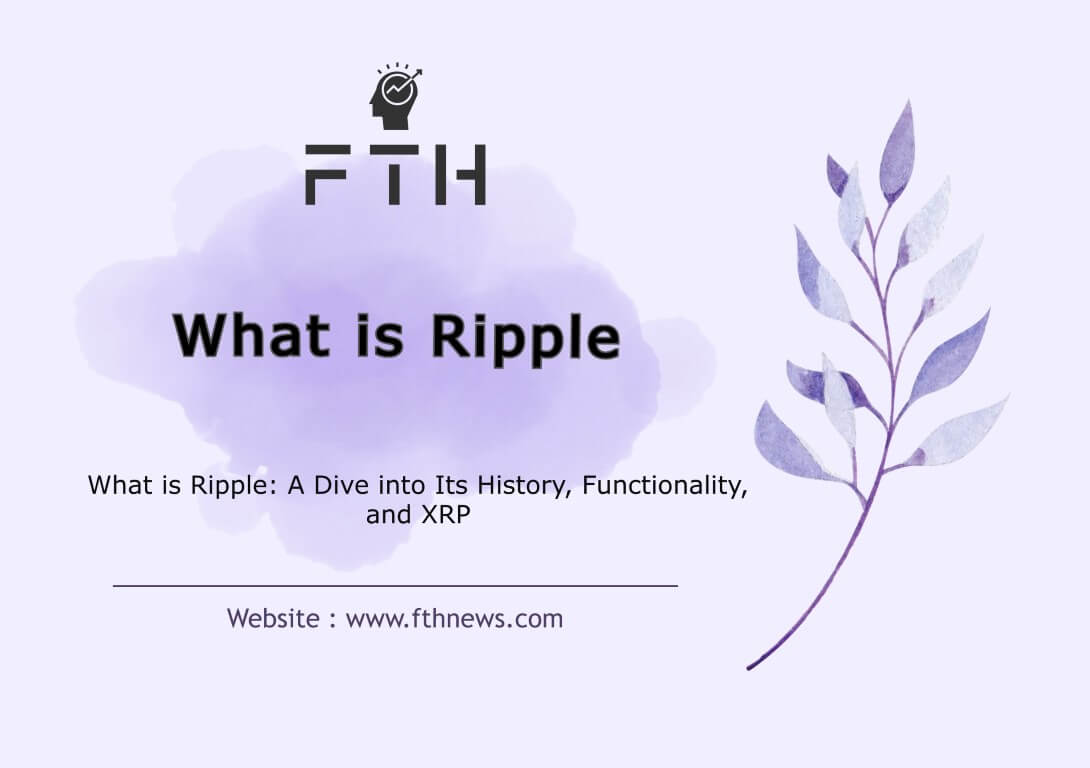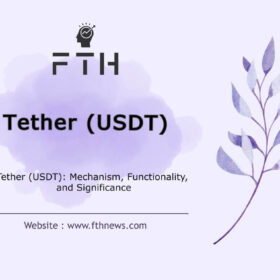
What is Ripple: A Dive into Its History, Functionality, and XRP
When the term XRP is mentioned, the immediate association is often with the symbol of this digital currency. However, it’s crucial to understand that Ripple and XRP are distinct entities. Unlike other digital currencies such as Bitcoin and Ethereum, comparing Ripple directly isn’t entirely accurate.
It’s essential to note that in the context of digital currency communities, the mention of Ripple often refers to the same currency as XRP, even though the two concepts are separate. Ripple, headquartered in San Francisco, is a prominent company in the cryptocurrency space. The company specializes in developing decentralized financial products tailored for banks and financial institutions. Ripple’s primary objective is to revolutionize interbank and international money transfers, aiming to make them more cost-effective, rapid, and decentralized. Notably, this objective has seen significant progress, with many banks and financial institutions now utilizing Ripple’s products for currency transfers. When you invest in Ripple, you’re essentially investing in one of the products offered by the company.
It’s essential to grasp that Ripple operates as both a platform and a cryptocurrency, featuring an open-source protocol. Facilitating swift and economical transactions is one of Ripple’s core strengths. Unlike Bitcoin, Ripple aspires to govern international transactions on a global scale. While this goal is ambitious, it raises interesting possibilities for the future, where exchanges might evolve or even cease operations, akin to various organizations that have adapted to changing landscapes.
Ripple has developed its own suite of products, with XRP being one of them, contributing to the broader ecosystem of this innovative platform.
What is RippleNet?
RippleNet functions as a sophisticated network that connects institutional payment providers, including banks and money service companies. It leverages advanced solutions to facilitate the seamless transfer of money globally. To illustrate its efficiency, consider a scenario where Mr. Jones in New York possesses a box of chocolates, but he desires a ticket to a baseball game. Simultaneously, Miss Smith in Los Angeles owns a rare stamp and wishes to exchange it for a box of chocolates. Meanwhile, Mr. Brown in Alaska is seeking a rare stamp and holds a ticket to a baseball game in New York. In our conventional system, these individuals might never find each other, leaving their valuables unused. However, in Ripple’s ecosystem, they can communicate their preferences, and the system will seek the shortest and most economical combination to fulfill their requests.
RippleNet supports payments in any currency, including Bitcoin, and boasts a minimal internal transaction fee of $0.00001. Yes, you read that right — several zeros follow the decimal point.
What is XRP ?
XRP serves as a token facilitating value transfers within the Ripple network. Its primary purpose is to function as a digital currency intermediary for both digital and fiat currencies (traditional currencies like dollars, etc.). Describing XRP as a “wild card” is apt because it can be converted into any other currency. To minimize fees, it’s recommended to exchange dollars for dollars and euros for euros, rather than exchanging dollars directly for euros. As mentioned earlier, the transaction fee is an infinitesimal $0.00001.
Notably, after each transaction, the amount of $0.00001 essentially “disappears” from the system and cannot be recovered. This policy is a deliberate measure by Ripple to deter spammers.
Presently, Ripple offers three main products for banks and financial institutions: “xCurrent,” “xRapid,” and “xVia.”
What is xCurrent?
xCurrent serves as a platform for banks and financial institutions to execute international payments. Operating on a distributed ledger called Interledger, it’s worth noting that while Ripple created this ledger, it is not under the company’s control. The non-profit Consortium (W3C) oversees and regulates this distributed ledger, setting and controlling international web standards.
The primary objective of xCurrent is to enable fast and instantaneous payments and transactions with all currencies, not just digital currencies.
What is xRapid?
xRapid addresses liquidity challenges in interbank transactions by directly utilizing XRP. This Ripple product converts fiat money into XRP and, upon transfer, changes it into the required currency at the destination bank. In this process, the source bank doesn’t need to involve an intermediary or liquidity provider to communicate with the destination bank. For instance, if a Turkish company purchases raw materials from a Japanese counterpart, the transaction on the xRapid system unfolds as follows:
xRapid purchases XRP with lira from the Turkish company and converts it to Japanese yen to reach the destination bank. The algorithm is meticulously designed to find the optimal price for converting lira to yen and yen to lira. Consequently, the Turkish bank doesn’t need to maintain Japanese yen in a broker bank in Japan, eliminating the need for a liquidity provider to convert currencies.
What is xVia?
xVia serves as a user interface designed for simplicity, offering a more user-friendly experience compared to xCurrent and xRapid. Its primary function is to facilitate seamless communication between various Ripple products in an uncomplicated manner.
What is the Purpose of Ripple?
Ripple envisions creating a secure and decentralized communication payment network for financial institutions globally. In stark contrast to Bitcoin’s objective of fostering peer-to-peer transactions and eliminating intermediaries and banks, Ripple holds the belief that banks themselves aren’t inherently negative. Instead, it’s the conventional methods they employ that lead to issues in payment and currency transfers.
Ripple aims to revolutionize international currency exchanges by providing decentralized banking products, with a focus on solving the persistent problems associated with currency transfers by banks and financial institutions. Annually, over $155 trillion is transferred internationally, and despite technological advancements, these transactions often take 3 to 7 days, involving substantial fees and extensive paperwork. Ripple aims to bring an end to these challenges.
It’s worth noting that Ripple faces stiff competition from established entities such as the Swift online currency transfer system, where Ripple’s advantage lies in the speed of transactions. Additionally, Stellar stands out as another formidable competitor in the realm of digital currencies.
Who Created Ripple?
The inception of the Ripple protocol dates back to 2004 as a prototype. However, the project gained momentum in 2013 when Jed McCaleb, the creator of the eDonkey network, invited a group of esteemed investors to join the Ripple venture. Shortly thereafter, the Ripple project officially commenced, marking the beginning of its journey.
What is the Ripple Protocol Consensus Algorithm (RPCA)?
Unlike Bitcoin and Ethereum, Ripple operates without a traditional blockchain. This might seem unusual, raising questions about how transactions are verified without a blockchain. To address this, Ripple employs its own technology known as the “Protocol Consensus Algorithm” (RPCA).
In the context of RPCA, “consensus” implies that as long as every node aligns with its peers, transactions proceed smoothly. To illustrate, envision an ancient city where crucial decisions require unanimous approval from a hundred wise elders. If all elders agree, actions like starting or ending a war, raising taxes, or organizing events proceed. However, if even one dissents, actions are halted until the disagreement is resolved.
Ripple’s History and Team
Founding of RipplePay (2004)
The roots of Ripple trace back to 2004 when Ryan Fugger founded RipplePay, predating the emergence of Bitcoin by four years. RipplePay aimed to establish a peer-to-peer protocol, fostering a reliable network for seamless global money transfers accessible to all Internet users. The company introduced itself as a financial service facilitating credit and financial connections among friends, family, and colleagues, enabling secure payments in both traditional and online currencies.
Despite its promising concept, RipplePay encountered technical and managerial challenges, limiting its success. Until 2011, the company had signed cooperation agreements with only a few entities, and its user base remained relatively small.
Jed McCaleb’s Involvement (May 2011)
In May 2011, Jed McCaleb, a notable figure in the early Bitcoin community and founder of the renowned Mt Gox exchange, joined the Ripple team. McCaleb persuaded Fugger to relinquish control of the company, marking a turning point in Ripple’s trajectory.
Entry of Chris Larsen (2012)
The arrival of Chris Larsen in 2012 marked a significant shift in Ripple’s journey. Larsen, mentioned as one of Ripple’s founders on the current website, brought considerable experience in technology to the team. This period also saw the company undergo a name change to Opencoin.
Investments and Key Figures (2012-2013)
In October 2012, Jesse Powell, founder and CEO of Kraken and a close friend of McCaleb, invested $200,000 in Ripple. Other notable figures, including Roger Ver, one of the creators of Bitcoin Cash, also became early investors.
Introduction of XRP (January 2013)
Ripple introduced its native tokens, XRP, in January 2013. Built on a public blockchain with cryptographic signatures, XRP does not require an initial trust-based network or gateways for transfers. It can be directly exchanged between users without intermediary risks.
Funding and Growth (April 2013)
In April 2013, Ripple (formerly Opencoin) secured funding from prominent entities such as Google Ventures, Andreessen Horowitz, IDG Capital Partners, FF Angels, Lightspeed, Bitcoin Opportunity Fund, and West Ventures, amounting to $1.5 million.
Jed McCaleb’s Departure and Stellar Supply (2014)
Differences between Jed McCaleb and the Ripple team, particularly with Chris Larsen, led to McCaleb’s departure in 2014. McCaleb believed that Ripple’s direction had shifted from its original vision. Subsequently, he joined the Stellar team and became one of the founders of Stellar.
This sequence of events outlines the evolution of Ripple, marked by strategic shifts, notable partnerships, and the eventual emergence of key figures in the cryptocurrency landscape.
A Four-Year Climax (2014-2018)
Between 2014 and 2018, Ripple experienced a remarkable period of exponential growth. The journey began in 2014 when the price of XRP, Ripple’s digital currency, surged by several hundred percent. Surpassing Litecoin (as Ethereum had not yet been released), XRP claimed the second position in the market. Over the subsequent four years, Ripple solidified its position by forging partnerships with over 100 banks and major financial institutions. Additionally, the company obtained numerous licenses from the United States government.
The pinnacle of Ripple’s success was evident in early 2018, when its total market value soared to over $100 billion. Achieving such a milestone in a relatively short span was a feat few companies in America had accomplished.
As of now, Brad Garlinghouse serves as the CEO of Ripple, while Chris Larsen holds a senior position on Ripple’s Board of Directors. The Ripple team comprises industry experts in technology and marketing, boasting experience gained from working in renowned companies such as Facebook, Yahoo, and Google. This amalgamation of expertise positions Ripple at the forefront of innovation in the cryptocurrency and blockchain space.
Difference Between Bitcoin and Ripple
While Ripple and Bitcoin share some common ground in the world of digital currencies, several fundamental differences set them apart.
1. Validation Servers and Consensus Mechanism:
The validation servers and consensus mechanism associated with Ripple often lead to the misconception that it operates on blockchain technology. However, Ripple employs a consensus-based approach, distinct from Bitcoin’s blockchain foundation. Designed primarily for large-scale enterprises, Ripple focuses on facilitating rapid, secure, and cost-effective global money transfers. Although Ripple is also used for person-to-person payments, it isn’t its primary focus.
2. Transaction Speed and Scalability:
Ripple’s core objective is to transfer substantial sums of money globally at exceptional speeds. Since its release, XRP has demonstrated stability, processing over 35 million transactions without significant issues. Notably, XRP can handle 1,500 transactions per second (TPS), with an ambition to eventually match Visa’s capability of 50,000 TPS. In comparison, Bitcoin manages 3-6 TPS, and Ethereum achieves 15 TPS.
3. Mining and Token Creation:
Unlike Bitcoin, Ethereum, and various other cryptocurrencies that rely on mining, Ripple’s native token, XRP, is not mined. Instead, 100 billion XRP coins were released at the platform’s inception. It’s important to note that the use of XRP is entirely independent of the Ripple network. Banks and financial institutions leveraging the Ripple platform for currency transfers do not require XRP. This distinction is crucial for small investors to remember when considering XRP as an investment.
In summary, while both Bitcoin and XRP operate within the digital currency realm, their underlying technologies, purposes, and approaches to transactions distinguish them significantly. Ripple’s focus on catering to large-scale financial entities and optimizing transaction speed positions it uniquely in the cryptocurrency landscape.
Ripple Network Roadmap
The Ripple network has not officially provided a written roadmap. However, some of the goals achieved include increasing database capacity, enhancing client access, improving access to XRP services, introducing a debit card, refining site services, and enabling communication with other cryptocurrencies.
Moreover, the XRPL Foundation was established on September 24, 2020, with the mission of accelerating the development and adoption of the XRP decentralized ledger. This foundation aims to support the growth of the Ripple network by assisting developers planning to utilize the XRP Ledger.
Is Ripple Decentralized?
The question of whether Ripple is centralized or decentralized remains a prominent debate in the crypto space. Various factors need consideration when determining the decentralization of a cryptocurrency. In the case of Ripple’s cryptocurrency, XRP, certain factors raise concerns about centralization. For instance, Ripple, as a single entity, owns more than 50% of the network’s voting power, and a significant portion of the coins (78%) belongs to the hundred richest addresses, with Ripple being the wealthiest.
Comparing XRP with Bitcoin, where miners receive mining rewards, XRP lacks a similar incentive structure. This has led to the perception that XRP is heavily under the control of Ripple.
Official SEC Complaint Against Ripple
On December 22, 2020, the US Securities and Exchange Commission (SEC) filed a lawsuit against Ripple Labs and its former and current CEOs, Christian Larsen and Bradley Garlinghouse. The SEC alleged that Ripple Labs raised over $1.38 billion through the sale of XRP since 2013, constituting an illegal sale of unregistered securities.
The complaint focused on Ripple’s selling pattern of XRP, arguing that it violated securities laws. It cited the Howey investment contract test, contending that XRP met the elements of such a contract. The case triggered a significant market response, with XRP’s price dropping by nearly 25% within 24 hours.
In response, XRP and the SEC reached an agreement to end the case. The joint proposal submitted to the court involved providing confidential documents to the court in a summary set, allowing both parties sufficient time to review and consult on these documents. This agreement signaled the expected conclusion of the SEC case against XRP in 2023.
Notably, a significant event in the legal proceedings was the rejection of the SEC’s request to seal all documents related to William Hinman’s June 2018 speech. This development was seen as a major victory for Ripple, contributing to increased trading volume and XRP listings on various exchanges after the favorable court ruling.
For more in-depth coverage of the Ripple court ruling and its impact on other SEC-involved projects, further details are available in an article covering the topic. Ripple’s victory has notably resulted in XRP being listed on various exchanges, accompanied by a sharp increase in trading volume.
Uses of XRP Currency
Low Fee Exchange:
XRP acts as an intermediary, facilitating direct conversion between currencies and eliminating the need for the US dollar as an intermediary. This helps avoid double commissions associated with currency conversion.
Fast International Transactions:
With an average transaction time of 4 seconds, XRP significantly outpaces Bitcoin and traditional banks in transaction speed.
Payment Ecosystem:
Users can utilize XRP for quick and cost-effective transactions within the Ripple ecosystem.
Benefits of Ripple
Initially designed for daily payments, Ripple, and its XRP currency offer several advantages:
Transaction Speed and Cost: Transactions are faster and cheaper compared to Bitcoin.
Official Organization: Ripple, as an official organization, undergoes fewer compliance checks than many other digital currencies.
Versatility: XRP can be exchanged for various currencies and assets, including gold.
Disadvantages of XRP Currency
Centralization: XRP is often criticized for its centralization and policy, leading some to view buying XRP as an investment in a bank.
Ownership Concentration: Ripple Labs owns 61% of XRP, giving rise to concerns about exclusivity.
Security Concerns: As an open-source protocol, Ripple is susceptible to potential hacking attempts.
Why is Ripple Criticized?
XRP faces criticism for several reasons:
Lack of Bank Confidence: Despite many banks testing Ripple, confidence remains an issue, leading to the potential blocking or suspension of transactions.
Founder Controversy: Rumors circulate regarding founder Jed McCaleb violating contract rules when attempting to sell XRP for over $1 million.
Ripple Wallets
While Ripple’s official website doesn’t provide an official wallet, there are trusted options available, including the Ledger wallet – a secure hardware wallet supporting various digital currencies.
Banks Supporting XRP Currency
Several banks support XRP, including Santander, Axis Bank, Yes Bank, Westpac, Union Credit, NBAD, and UBS.
Exchanges Trading Ripple Digital Currency
Popular exchanges facilitating XRP transactions include Binance, OKEx, Bybit, and Coinex. Binance, in particular, dominates XRP transactions.
FAQ
Investment decisions depend on individual preferences and market analysis. Conduct thorough research before deciding
Ripple is a San Francisco-based company providing decentralized financial products, aiming to streamline international money transfers for banks.
Predicting specific values is challenging. Ripple’s price is influenced by market dynamics and external factors.
Future cryptocurrency values are uncertain. Various factors impact XRP’s price, making predictions challenging.
The U.S. SEC sued Ripple, alleging the illegal sale of unregistered securities through XRP.
The lawsuit’s outcome is subject to ongoing legal proceedings. Recent developments indicate positive trends for Ripple.
Ripple aims to revolutionize international currency exchanges, making them faster, cheaper, and more efficient.
Ripple generates revenue through its suite of financial products, including xCurrent, xRapid, and xVia, designed for banks and financial institutions.
Ripple is a privately-owned company. Major stakeholders include co-founder Chris Larsen and CEO Brad Garlinghouse.














